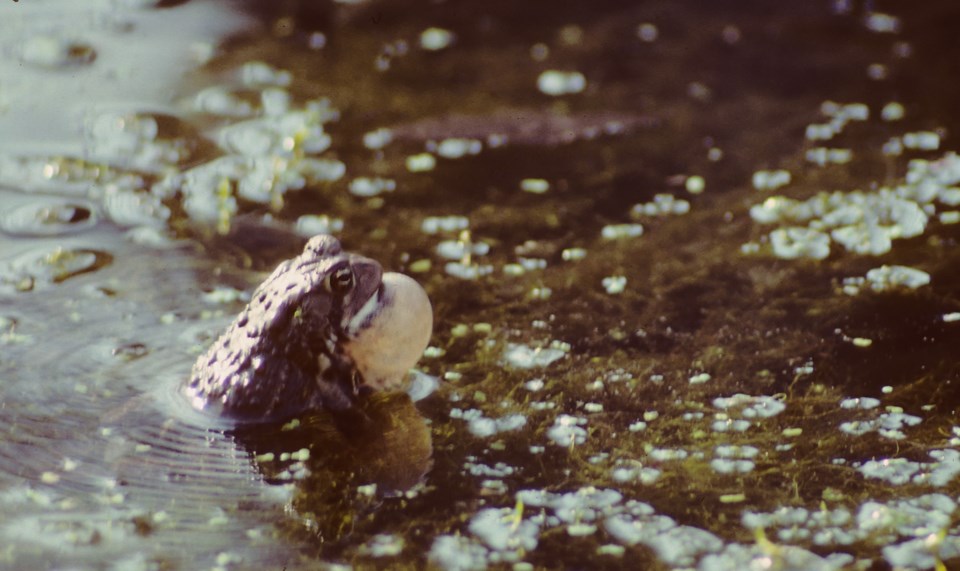It starts with a single peep, usually on an April eve. Just a peep. Then another, and another and another!
By hour's end, you may not be able to tell where one peep stops and another begins. It's a new season and the little spring peeper frogs are letting us know that they're in the mood for love; at least a little amphibian lusty kinda love. Well, hey, Peep, baby!
Our local wetlands, those swamps, marshes, bogs, fens and other assorted soggy areas are the venues for the annual "frog calling" championships.
With nine species of frogs plus a toad thrown into the mix, our region becomes an orchestra of amphibian song. Indeed, the ability to 'sing' sets these species apart from other amphibians such as salamanders and newts.
Each frog species has its own unique song, maybe a peep, perhaps a quack, or in the case of the toad, a trill. Just as advanced birdwatchers use the calls to identify their feathered targets of interest, frog watchers utilize the same technique.
And just like shy birds, trying to actually see a frog performing its solo recital is very difficult to achieve. Although the cacophony coming from the pond may indicate that there are hundreds of frogs partying it up, one crack of a stick underfoot, one car door shut a little too heavily... and silence descends, immediately and completely.
That big round spot on a frog's head, just behind the eye, is called a tympanum. Tympanum is the biological equivalent of 'ear'.
Both sexes have them, although the males usually have a tympanum that is larger in diameter than their eye. Which seems odd as one might think that the females should have the larger ears to home in on the calling males.
However, when studied closely, the males are trying to out-compete each other, and are stimulated to congregate around the loudest singer as he may be having the most success at luring in the ladies.
Many of the lesser males act like roadies in a touring music show, as when the females flock in and wait in line to see the big guy, these guys sidle in and make their move.
Other studies of frog calls and hearing have shown that there is close relationship between what a frog hears and what a frog sees.
A frog sitting on the shore of a pond, patiently waiting for a fly to buzz by within tongue-grasping range, has a vision field between three and 10 feet (or one to two metres for you younger folks).
This range will detect predators such as a great blue heron, a raccoon, or a kid with a dip net, but also causes it to miss the worm crawling right under its nose.
If large movement is detected, the frog will jump into the pond with a splash and make a warning cry.
This little splash is heard by the next frog and it too leaps with great concern back into the pond. And so on down the pond's edge it goes, each frog in line becoming more panicked by the rainfall of plops heard coming down the shore.
Once in the water, their tympanum (that ear thingy) becomes heightened to pick up sound, and so your next step no matter how soft and concealed you thought it was, it readily picked up by the frogs now floating with just their noses poking above the water.
"Don't nobody move, whatever it is, it's still out there!"
And if that frog, back when it was sitting undisturbed on the shore, hears the high-pitched whine of an approaching deer fly, it will adjust its vision from three-to-ten feet down to one-to three-feet, thus ready to focus on the incoming meal.
Outside of courtship, the ear-eye coordination of frogs is a really successful adaptation to staying alive.
Each species has its own temperature threshold as to when it will start singing. This related back to resource partitioning, a topic discussed here a few weeks ago.
A pond may be home to several species of frogs and if they all started calling at the same time it would be a confusing mish-mash of noise, similar to you trying to have a romantic conversation is a noisy sports bar.
So first the wood frogs and spring peepers give it a go (even with ice still on the pond), then the leopard and mink frogs. Soon after are heard the green frogs. Late spring, when it has become quite warm, the bull frogs will begin tuning up.
The number of humans who chase frog calls is quite high, so several websites have been set up to let you in on their secrets of listening for what's out there.
And how to report what you're hearing. Frogs are very sensitive to changes in water quality, air quality and temperature fluctuations, thus making them akin to the 'canary in the mineshaft'... if the frogs disappear first, we're not too far behind.
If this spring weather ever warms up to a decent level, take a wander on a warm eve down to the local pond, and take that someone special with you, as a "froggie would a wooing go."



